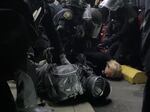It’s been nine months since Portland’s mayor and police chief triumphantly announced the city was nearing the end of its six-year journey with the U.S. Department of Justice to address the use of excessive force by the city’s police on people experiencing mental illnesses. But after months of protests that have seen the bureau’s use of force numbers skyrocket, some predict this journey may be far from over.
Since 2014, the city of Portland has been working its way through requirements laid out in a settlement agreement with the Department of Justice after a federal investigation found a pattern of Portland Police officers using excessive force on people who experience mental illnesses. Last January, the city announced it was nearing the finish line. DOJ officials had found the city in ‘substantial compliance’— the legal way of saying the city had fulfilled most of the requirements laid out in the 77-page agreement intended to shepherd the city through a host of police reforms.
The finding started the clock: If the city could keep those boxes ticked for one year, the agreement would end — an outcome sought after by many in City Hall who say the federal agency is now getting in the way of local police reform and believe it’s high time for the city to regain full control over its force.
But the police’s handling of months of racial justice protests has some questioning whether the city could really still be in compliance. Paperwork has piled up, jeopardizing the city’s ability to fulfill the parts of the agreement that require the city to promptly review uses of force and investigate allegations of misconduct. And the police, armed with batons, CS gas and throwing the occasional punch, have torn some gaping holes in the argument that the bureau has meaningfully reigned in its use of force.

Portland police officers make arrests during the 113th night of demonstrations for racial justice in the city.
Sergio Olmos
In terms of the sheer quantity of use-of-force incidents, 2020 will be, far and away, the most violent year on record for the police bureau since the city reached the settlement agreement with DOJ. According to new numbers released by the bureau Friday, police used force at protests over 6,000 times during a period stretching from the beginning of April through the end of September. That includes a minimum of 216 baton strikes, 433 uses of pepper spray, and the firing of impact munitions 1,566 times
“Whether you’re doing the bean counter method or just kind of looking at this big picture and saying, ‘Wow, that’s really a lot of use of force on civilians by police officers,’ I just don’t think that even in that very sort of general way of looking at it, that you could really think that the city is in compliance,” said Ross Caldwell, the head of the Independent Police Review, the city’s police oversight agency.
The city got a reminder last month that the police bureau was trending in the wrong direction. A team tasked with overseeing Portland’s compliance with the agreement released a quarterly report with a striking finding: the city was no longer within the realm of “substantial compliance.”
The report, which analyzed a period beginning in July through the end of September, noted the bureau had been faced with “extraordinary circumstances” amid a public health crisis, sustained protests, and budget cuts leaving the force stretched-thin. But the authors noted they had been tasked to evaluate whether the systems “designed to ensure constitutional policing” continued to function during this year — no matter how unprecedented of a year it was. They found the city had not kept up.
The report pointed to two specific sections of the agreement where police had lost ground: training and use of force. Amid protests and a pandemic, the authors said the bureau couldn’t provide a thorough accounting of the times they used force and officers weren’t getting their required training in de-escalation, use of force and crowd control.
But the authors left the door open for the bureau to claw its way back into compliance: “Our conversations with PPB indicate that they have concrete plans for returning to substantial compliance in the near future,” the report read.
Portland Mayor Ted Wheeler, who also serves as the police commissioner, has said he, too, believed the bureau would get where it needed to be despite the pandemic and protests forming a perfect storm to blow the force off course.

Mayor Ted Wheeler, center, stands at the fence outside the Mark O. Hatfield federal courthouse in Portland, Ore., as federal officers deploy tear gas July 23, 2020. People protesting police violence and systemic racism have been subject to tear gas, impact munitions and other dispersal tactics by PPB and federal law enforcement for nearly two months.
Rebecca Ellis / OPB
“I’ve made it very clear to the police chief that I expect the city of Portland’s Police Bureau to be in compliance and in substantial compliance with the DOJ settlement agreement,” said Wheeler in a recent interview. “It’s my understanding they’re already making up that backlog now.”
Caldwell, faced with a backlog of his own at the Independent Police Review, is less confident. With protest-related complaints against officers flooding the agency, he said there’s little question they will be unable to meet the timelines required of them in the settlement agreement to investigate misconduct allegations. And he’s skeptical DOJ officials will let it slide.
“I don’t think the DOJ is going to give the city a pass because you say, ‘Well we’ve got all these protests now, so we don’t really have to play by the rules anymore.’ The rules are not only for the off season when there aren’t protests,” he said. “I would be shocked if they gave us a pass. In my experience, they’re not in the giving a pass business.”
The DOJ will need to make a decision on whether the city remains in substantial compliance before a court hearing on the agreement in February. Should the DOJ find the city has backslid, the city’s police bureau could remain under federal oversight for the foreseeable future.
It would be a blow to some in City Hall eager to regain full autonomy of the city’s police force.
“The settlement agreement has ... required us to spend tens of millions of dollars inside the Portland Police Bureau,” said Commissioner Jo Ann Hardesty in an interview last month. “And we are killing more people today than we did before the DOJ came to town, who are suffering from mental health issues. So clearly the fix was not the appropriate fix for what was wrong with Portland police.”

Portland City Commissioner Jo Ann Hardesty listens to testimony over a proposed ordinance on April 4, 2019.
Kaylee Domzalski / OPB
If the city’s booted out of the compliance period, it could spell trouble for some of the protest-inspired police reforms the city is planning for the near future — most notably, the new police oversight board voters approved Nov. 3. This board, empowered to discipline and fire police officers, is meant to replace the Independent Police Review. Yet the settlement agreement states that the city must “strengthen and retain” the Independent Police Review.
Asked about the contradiction, Hardesty, who championed the new oversight board and whose office is working to get it off the ground, painted it as a question of timing. The Independent Police Review will stick around until the new board gets off the ground — a process that could take over a year.
“Nothing happens to IPR until the board is actually seated,” she said.
There’s also a proposed munitions ban that could get snagged in the teeth of the agreement. Over the summer, both Hardesty and Commissioner Chloe Eudaly talked publicly about bringing a ban on police munitions to the council that included tear gas and rubber bullets. According to Eudaly’s office, they were told by the city attorney that DOJ officials keep a tight grip on changes to PPB’s use of force policy and might take issue with the ban. The office has shifted to working on a rule that focuses on inventorying the bureau’s munition stockpile and would require quarterly reporting to the council.
“The DOJ Settlement agreement plays a pretty large part in determining what we put on the table,” said Hannah Holloway, a senior policy advisor to Eudaly, who has been working on the proposed ban. “We’ve been working on this since June trying to find a way to work within the DOJ constraints. But it’s just incredibly challenging to do any sort of police reform measures we want to do through council action.”
Not everyone believes the city should be done with the requirements. At a court hearing last February, U.S. District Judge Michael Simon, who has been overseeing the agreement, heard testimony from community members arguing the police bureau was nowhere near where it needed to be regarding community engagement. Testifiers that day rebuked the 13-member Portland Committee on Community-Engaged Policing, known as PCCEP, as dysfunctional, inefficient, and hardly the effective community oversight body that the settlement agreement requires.
Others point to a more basic reason the city shouldn’t be found in compliance with the agreement. The DOJ came to Portland with a mission to reduce the Portland Police Bureau’s disproportionate use of force on people experiencing mental illnesses. Advocates say it has not worked.
The data released last week that showed the bureau’s use of force tally in the thousands also showed use of force on people experiencing mental illnesses had reached a new high.
The report says the bureau used force on people experiencing mental health crises 244 times between July and September. That’s the highest figure since the bureau started tracking it quarterly in late 2015.
“Whether you want it wordsmith or play lawyer with it or not, we’ve failed to address the problem,” said Jason Renaud, part of the Mental Health Alliance, a coalition of mental health advocates that has an amicus curie — or “friend of the court” — status in the case.
“If we close the settlement agreement we’re going to close the book on all this work around mental illness that hasn’t been done. The debt is still there. Time does not make it go away.”
